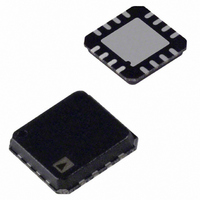AD7879ACPZ-RL Analog Devices Inc, AD7879ACPZ-RL Datasheet - Page 32

AD7879ACPZ-RL
Manufacturer Part Number
AD7879ACPZ-RL
Description
IC ADC 12BIT CTLR TOUCH 16LFCSP
Manufacturer
Analog Devices Inc
Type
Touch Screen Controller: 4-Wire Resistiver
Datasheet
1.AD7879-1ACPZ-RL.pdf
(36 pages)
Specifications of AD7879ACPZ-RL
Resolution (bits)
12 b
Data Interface
I²C
Package / Case
16-LFCSP
Mounting Type
Surface Mount
Voltage - Supply
1.6 V ~ 3.6 V
Operating Temperature
-40°C ~ 85°C
Voltage Supply Source
Single Supply
Sampling Rate (per Second)
105k
Sampling Rate
105kSPS
Supply Voltage Range - Analog
1.6V To 3.6V
Supply Current
480µA
Digital Ic Case Style
CSP
No. Of Pins
16
Lead Free Status / RoHS Status
Lead free / RoHS Compliant
Available stocks
Company
Part Number
Manufacturer
Quantity
Price
Company:
Part Number:
AD7879ACPZ-RL
Manufacturer:
Maxim
Quantity:
50
AD7879
DOUT
I
The AD7879-1 supports the industry standard 2-wire I
interface protocol. The two wires associated with the I
the SCL and SDA inputs. The SDA is an I/O pin that allows both
register write and register read back operations. The AD7879-1 is
always a slave device on the I
It has a 7-bit device address, Address 0101 1XX. The lower two
bits are set by tying the ADD0 and ADD1 pins high or low. The
AD7879-1 responds when the master device sends its device
address over the bus. The AD7879-1 cannot initiate data transfers
on the bus.
Table 23. AD7879-1 I
ADD1
0
0
1
1
Data Transfer
Data is transferred over the I
master initiates a data transfer by establishing a start condition,
defined as a high-to-low transition on the serial data line, SDA,
while the serial clock line, SCL, remains high. This indicates
that an address/data stream follows.
2
SCL
DIN
C-COMPATIBLE INTERFACE
CS
NOTES
1. MULTIPLE REGISTERS CAN BE READ BACK CONTINUOUSLY.
2. THE 16-BIT CONTROL WORD MUST BE WRITTEN ON SDA: 5 BITS FOR ENABLE WORD, 1 BIT FOR R/W, AND 10 BITS FOR REGISTER ADDRESS.
3. THE ADDRESS AUTOMATICALLY INCREMENTS WITH EACH 16-BIT DATA-WORD BEING READ BACK ON THE SDA PIN.
4. CS IS HELD LOW UNTIL ALL REGISTER BITS HAVE BEEN READ BACK.
5. X DENOTES DON’T CARE.
6. XXX DENOTES HIGH IMPEDANCE THREE-STATE OUTPUT.
7. 16-BIT COMMAND WORD SETTINGS FOR SEQUENTIAL READBACK OPERATION:
XXX XXX XXX
CW[15:11] = 11100 (ENABLE WORD)
CW[10] = 1 (R/W)
CW[9:0] = [AD9, AD8, AD7, AD6, AD5, AD4, AD3, AD2, AD1, AD0] (STARTING MSB JUSTIFIED REGISTER ADDRESS)
CW
15
1
ENABLE WORD
CW
14
2
ADD0
0
1
0
1
CW
13
3
XXX XXX XXX XXX XXX XXX XXX
CW
2
12
C Device Address
4
CW
11
2
2
C serial interface in 8-bit bytes. The
C serial interface bus.
5
R/W
CW
10
16-BIT COMMAND WORD
6
I
0101 100
0101 101
0101 110
0101 111
CW
2
9
C Address
7
CW
8
8
CW
7
9
Figure 41. Sequential Register Read Back SPI Timing
REGISTER ADDRESS
CW
6
10
2
C timing are
2
XXX XXX XXX
C serial
CW
5
11
CW
4
12
Rev. 0 | Page 32 of 36
CW
3
13
XXX XXX
CW
2
14
CW
1
15
All slave peripherals connected to the serial bus respond to the
start condition and shift in the next eight bits, consisting of a
7-bit address (MSB first) plus an R/ W bit that determines the
direction of the data transfer. The peripheral whose address
corresponds to the transmitted address responds by pulling the
data line low during the ninth clock pulse. This is known as the
acknowledge bit. All other devices on the bus then remain idle
while the selected device waits for data to be read from, or
written to it. If the R/ W bit is a 0, the master writes to the slave
device. If the R/ W bit is a 1, the master reads from the slave
device.
Data is sent over the serial bus in a sequence of nine clock
pulses (eight bits of data followed by an acknowledge bit from
the slave device). Transitions on the data line must occur during
the low period of the clock signal and remain stable during the
high period, because a low-to-high transition when the clock
is high can be interpreted as a stop signal. The number of data
bytes transmitted over the serial bus in a single read or write
operation is limited only by what the master and slave devices
can handle.
When all data bytes are read or written, a stop condition is
established. A stop condition is defined by a low-to-high
transition on SDA while SCL remains high. If the AD7879
encounters a stop condition, it returns to its idle condition.
XXX D15
CW
0
16
STARTING REGISTER ADDRESS
X
17
READBACK DATA FOR
D14
X
18
D1
X
31
D0
X
32
D15
X
33
NEXT REGISTER ADDRESS
READBACK DATA FOR
D14
X
34
D1
X
47
D0
X
48
D15
X
49









